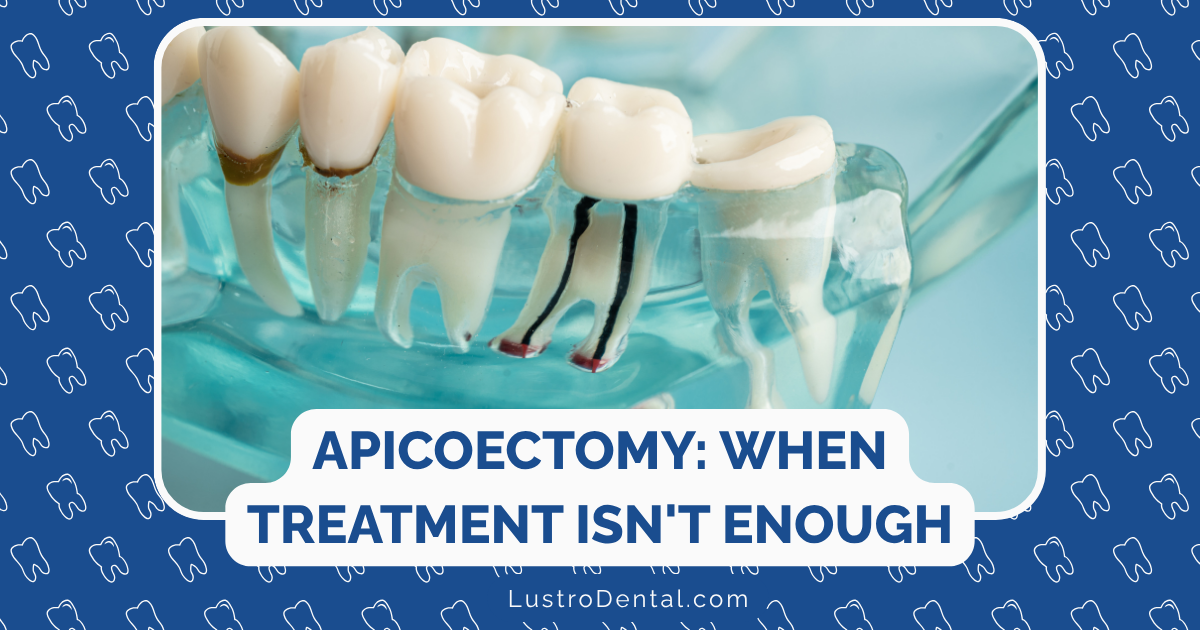Beyond Root Canals: When Apicoectomy Becomes Necessary

When a root canal procedure doesn’t resolve your dental issues, it can be frustrating and concerning. You’ve already invested time, money, and endured treatment, only to find that symptoms persist or new problems develop. In these situations, an apicoectomy—a specialized endodontic surgical procedure—may become necessary.
As someone who’s guided many patients through this journey, I understand the questions and concerns that arise when considering this next step in treatment. In this article, I’ll explain what an apicoectomy is, when it becomes necessary, what to expect during the procedure, and the outcomes you can anticipate.
What Is an Apicoectomy?
An apicoectomy (also called root-end surgery or root-end resection) is a minor surgical procedure that focuses on the tip (apex) of a tooth’s root. During the procedure, an endodontist:
- Makes a small incision in the gum tissue to expose the bone and infected tissue
- Removes the infected tissue along with the very tip of the root
- Places a small filling to seal the end of the root canal
- Closes the gum tissue with stitches to allow healing
Dr. Sarah Johnson, endodontist at Olympic View Dental, explains: “Think of an apicoectomy as addressing the problem from the other direction. Instead of accessing the root canal through the crown as in traditional root canal therapy, we approach it through the gum tissue to directly treat the root tip where infection often persists.”
When Does an Apicoectomy Become Necessary?
An apicoectomy isn’t the first line of treatment for tooth infections. It’s typically considered only after other options have been explored. Here are the most common scenarios where an apicoectomy becomes necessary:
1. Persistent Infection After Root Canal Treatment
The most common reason for an apicoectomy is when a tooth that has undergone root canal therapy continues to show signs of infection. This might be evident through:
- Persistent pain or discomfort
- Swelling in the gum tissue near the treated tooth
- A pimple-like bump (fistula) on the gum
- Radiographic evidence of continuing or new infection at the root tip
2. Complex Root Anatomy
Some teeth have anatomical features that make complete cleaning and filling through conventional root canal treatment challenging:
- Extra canals that weren’t identified or treated
- Extremely curved or narrow canals
- Accessory canals or lateral branches near the root tip
- Calcified canals that block access
Dr. Michael Chen, researcher at Journal of Oral Research and Review, notes: “Up to 15% of teeth have anatomical variations that can complicate endodontic treatment. These variations may only become apparent when conventional treatment fails to resolve the infection.”
3. Obstruction in the Canal
Sometimes physical barriers prevent complete cleaning and filling of the canal system:
- Separated instruments that couldn’t be removed
- Posts or other restorative materials that block access
- Calcifications that developed after the initial treatment
- Ledges or other procedural errors that prevent complete cleaning
4. When Retreatment Isn’t Feasible
In some cases, nonsurgical retreatment (redoing the root canal) might be technically difficult or unlikely to succeed:
- When a crown or bridge would be compromised by retreatment
- When multiple retreatment attempts have already failed
- When the cost-benefit analysis favors a surgical approach
According to Rochester Endodontics, “While retreatment is often the first choice when a root canal fails, there are situations where an apicoectomy offers a more predictable path to saving the tooth.”
The Apicoectomy Procedure: What to Expect
Modern apicoectomy procedures, especially those using microsurgical techniques, are precise and relatively comfortable. Here’s what typically happens:
Before the Procedure
- Detailed examination and diagnosis, often including 3D imaging (CBCT)
- Discussion of treatment options, risks, and benefits
- Preoperative instructions, which may include antibiotics if active infection is present
During the Procedure
- Anesthesia: Local anesthesia ensures you won’t feel pain during the procedure
- Access: A small incision in the gum tissue exposes the root tip and surrounding bone
- Removal of infected tissue: Inflamed or infected tissue is carefully removed
- Root-end resection: 3-4mm of the root tip is removed, eliminating most accessory canals and anatomical complexities
- Root-end preparation: A small preparation is made in the exposed root end
- Root-end filling: A biocompatible material (typically MTA—Mineral Trioxide Aggregate) is placed to seal the canal
- Closure: The gum tissue is repositioned and secured with stitches
The entire procedure typically takes 30-90 minutes, depending on the tooth location and case complexity.
Modern Microsurgical Techniques
Modern apicoectomies use advanced technology that significantly improves outcomes:
- Dental operating microscopes provide magnification (up to 25x) for precise visualization
- Ultrasonic instruments allow for more conservative and precise root-end preparations
- Microinstruments enable delicate tissue handling
- Biocompatible materials like MTA promote healing and provide excellent seals
A controlled clinical trial comparing traditional and microsurgical approaches found that modern techniques had a probability of success more than 5 times higher than traditional methods.
Recovery and Aftercare
Recovery from an apicoectomy is typically straightforward:
Immediate Post-Procedure (24-48 hours)
- Some swelling and discomfort are normal, peaking around the second day
- Over-the-counter pain medications are usually sufficient for pain management
- Ice packs applied externally can help reduce swelling
- Soft, cool foods are recommended
- Avoid brushing directly at the surgical site
Short-Term Recovery (1-2 weeks)
- Stitches are typically removed after 5-7 days
- Most patients return to normal activities within a day or two
- Avoid strenuous physical activity for a few days
- Continue gentle oral hygiene, avoiding the surgical site
- Complete a full course of any prescribed antibiotics
Long-Term Healing
- Bone healing around the root tip occurs gradually over months
- Follow-up appointments will monitor healing progress
- Full healing may take 6-12 months to be visible on x-rays
Dr. Lisa Wong of Endodontics of NYC advises: “Most patients are surprised by how quickly they recover from an apicoectomy. The majority return to work or school the next day with minimal discomfort that’s easily managed with over-the-counter pain relievers.”
Success Rates and Outcomes
Modern apicoectomy procedures have excellent success rates:
- Short-term success: 90-94% at 1 year with modern microsurgical techniques
- Long-term success: 75-97% at 5-10 years, depending on case selection and technique
- Traditional vs. microsurgical: 59% success with traditional techniques vs. 94% with microsurgical approaches
A 2020 study cited by Healthline found that about 97% of cases experienced excellent results following apical surgery up to 5 years later, with good results reported in more than 75% of cases after 10 to 13 years.
Apicoectomy vs. Alternatives: Making the Right Choice
When facing a failed root canal, several options exist:
1. Nonsurgical Retreatment
- Pros: Less invasive, addresses the entire canal system
- Cons: May not resolve issues caused by complex anatomy or obstructions
- Best for: Cases where the original root canal can be accessed and improved
2. Apicoectomy
- Pros: Addresses issues at the root tip directly, preserves existing restorations
- Cons: Surgical procedure, may not address issues in the main canal
- Best for: Failed root canals with good coronal restorations, anatomical complexities, or obstructions
3. Extraction and Replacement
- Pros: Eliminates the source of infection completely
- Cons: Loss of natural tooth, higher cost for replacement
- Best for: Teeth with poor prognosis due to fractures or severe structural compromise
Dr. Robert Wilson, endodontist at Avon Oral and Maxillofacial Surgery, emphasizes: “The decision between these options should be based on careful diagnosis, the specific reason for the initial failure, and the overall restorability of the tooth. Each case requires individualized assessment.”
Is an Apicoectomy Right for You?
Consider these factors when discussing treatment options with your endodontist:
Good Candidates for Apicoectomy
- Teeth with good restorations that would be challenging to replace
- Cases where the source of persistent infection is likely at the root tip
- Patients who want to preserve their natural tooth
- Teeth with obstructions that prevent nonsurgical retreatment
Situations Where Alternatives Might Be Better
- Teeth with significant structural damage or cracks
- Cases where infection extends throughout the canal system
- Teeth with severe periodontal (gum) disease
- Patients with medical conditions that contraindicate surgery
Conclusion: A Valuable Option for Saving Natural Teeth
An apicoectomy represents an important treatment option in the endodontist’s toolkit for saving natural teeth when conventional root canal therapy hasn’t achieved the desired outcome. With modern microsurgical techniques, this procedure offers high success rates, relatively quick recovery, and the opportunity to preserve your natural tooth for many more years.
If you’re experiencing persistent issues after root canal treatment, consult with an endodontist to determine if an apicoectomy might be appropriate for your situation. The specialized training, equipment, and expertise of an endodontist are crucial for achieving the best possible outcome with this procedure.
Remember, preserving your natural teeth whenever possible is generally preferable to extraction and replacement, both from functional and economic perspectives. An apicoectomy might be the solution that allows you to keep your natural tooth for years to come.
Have you undergone an apicoectomy or are you considering one? Share your experience or questions in the comments below!







